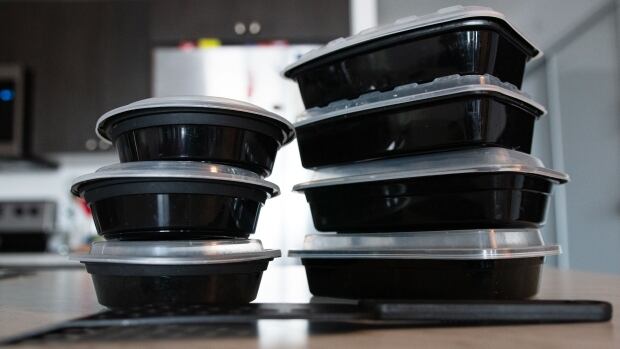
The Dose21:05How does black plastic affect my health?
Certain products made from black plastic — like the kind found in takeout containers, coffee lids and even kitchen utensils — is coming under fire by experts because of a recent study that found a lack of regulation around recycling is causing toxic chemicals to show up in household plastics.
In a study published in the journal Chemosphere in October, researchers from the U.S. and the Netherlands found brominated fire retardants (BFR) used to strengthen plastics for electronics in household products made with recycled black plastics in the U.S.
Fire retardants — including toxic, regulated compounds — were found in roughly 85 per cent of products analyzed by the study’s researchers. The items tested include kitchen utensils, food trays and even children’s toys.
“In many cases, when we come across black plastics in our kitchen, they are made from recycled electronic components that include cell phones, old computers and laptops that are not intended for human food applications,” said Tizazu Mekonnen, a University of Waterloo chemical engineering professor who was not involved in the study.
The study estimated that using contaminated kitchen utensils contributed to the ingestion of 34,700 nanograms of fire retardant decabromodiphenyl ether per day. The U.S. Environmental Protection Agency’s reference dose — or recommended limit — of 42,000 nanograms per day for an average 60 kilogram adult.
The study examined the amount of fire retardants in items made with black plastic, but not humans.
Mekonnen and other experts say that we should minimize the use of black plastic in our homes and kitchens to prevent plastic-related chemicals from possibly harming our health.
What is black plastic?
Black plastic is coloured using a substance called carbon black, according to Western University biochemist Elizabeth Gillies.
“This is essentially soot that is produced by the incomplete combustion of different materials like coal or petroleum products, or vegetable matter,” she said.
Concerns arise, however, when recycled plastic from electronics end up in household and kitchen plastics.
That’s because plastics in electronics contain compounds — like brominated fire retardants that help prevent the plastic from melting under high heat — which may be harmful when ingested in significant concentrations.
Thousands of delegates are in Ottawa trying to hammer out an historic treaty to end plastic pollution, but the road to get there is littered with hurdles. CBC’s Susan Ormiston examines why it’s so hard to curb the problem and what it will take for the world to agree on a plan.
What are the health concerns surrounding black plastic?
Physicians like Dr. Sehjal Bhargava say consuming food contaminated by the toxic compounds found in black plastic may contribute to serious health concerns, including cancer and fertility issues.
“The health impacts are not yet fully understood, but the evidence that’s emerging is not good news,” said Bhargava, an Ontario family physician and public health and medical resident at the University of Ottawa who sits on the board of the Canadian Association of Physicians for the Environment.
Mekonnen says the risk of harmful health effects is increased when black plastic products are heated up, like when containers are microwaved, or when utensils are used on a grill or stove.
“[If] your thermos lid is made of black plastic, the heating would increase the free volume of the polymer, which would allow the chemicals into the drink as well,” said Mekonnen.

Gillies says using black plastic utensils in hot oil is an additional concern. A 2018 study estimated that cooking with utensils, such as a spatula, contaminated with brominated fire retardants led to an average exposure of 60 nanograms per day.
“More research is needed on the safe exposure limits of BFRs for humans, but cooking regularly in oil with black plastic may result in a significant exposure,” wrote Gillies, in an email.
“That being said, if your black plastic spatula is older, a lot of BFRs would likely have already leached out, so ongoing exposure may be minimal.”
Using black plastic products at room temperature likely minimizes the harmful health consequences, according to Mekonnen.
More regulation needed to reduce reliance on plastics
Much of the concern around black plastic — including the issues raised in the Chemosphere study — stem from poor recycling infrastructure and weak regulations.
Canada’s single-use plastics prohibition regulations ban takeout containers containing carbon black, but not the other harmful compounds that may be found in products made from recycled black plastics.
Bhargava says EU countries have laws around using plastic from recycled electronics containing brominated fire retardants in new plastic products.
EU legislation limits the level of harmful fire retardants in consumer materials, and recycling material containing certain fire retardants above a specific limit is prohibited.
The World Health Organization has released a report on how it believes microplastics are affecting human health, and it sees them entering our bodies.
Canada currently bans the “manufacture, use, sale and import” of some toxic chemicals — including polybrominated diphenyl ethers (PBDE) used as flame retardants in black plastic — through existing regulations like the 2012 Prohibition of Certain Toxic Substances Regulations.
Amendments to those 2012 rules, expected in spring 2025, will “further restrict existing exemptions that allow the import of certain products, including recycled products, containing certain toxic substances and expand the number of chemicals that are restricted,” according to an Environment and Climate Change Canada (ECCC) spokesperson.
Canada is also part of an international agreement, the Stockholm Convention on Persistent Organic Pollutants, that prevents signatories from allowing certain banned compounds to be recovered, recycled, reclaimed or directly reused.
CBC requested comment from the Chemistry Industry Association of Canada, which represents plastics manufacturers, which declined to comment.
Bhargava says she’s concerned about loopholes that allow recycled plastics originally used in electronics to make their way into kitchen utensils.
“There are lots of loopholes and lack of regulation around the recycling of these electronic products,” said Bhargava.
Mekonnen agrees more needs to be done.
“Current studies show that we need a specific and targeted legislation to limit or ban the use of black plastic for food-related purposes,” he said.





